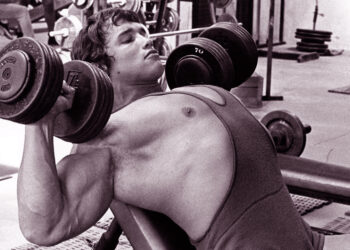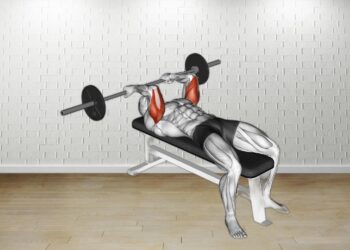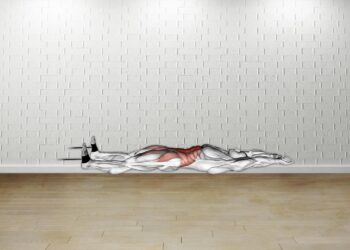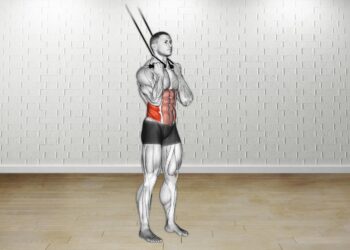The standing dumbbell one-leg calf raise is a home-gym staple and suitable replacement for dedicated calf machine training. That’s because the combination of your bodyweight and a dumbbell is typically more than enough resistance for most people including more advanced exercisers.
Aside from the convenience and versatility of machine calf training, there’s really no better way to stimulate your bulls than using this old-school exercise. And even if you don’t have access to dumbbells, it’s still a variation made possible by wearing a loaded up backpack, weighted vest, or holding any weighted item in your grip.
In this guide, we included tips and tricks to maximize your calf training, plus a list of benefits, our favorite variations, optimal sets and reps for this movement and more.
How To Do Standing Dumbbell One-Leg Calf Raises
Note: Before jumping into your first set of dumbbell calf raises, we recommend starting with a few minutes of light physical activity such as walking at a brisk pace, or a couple sets of two-legged bodyweight only calf raises done from the floor. This will get blood into your lower leg muscles and prepare your joints and tendons before moving your ankles through a larger range of motion under a weight load.
Now let’s go over the step-by-step process of proper pre-rep setup and movement execution.
Step 1: Choosing your platform
There are several different to do this exercise. You can use the spotting platform on a bench press station (ideal), a doorway step, staircase, training block, weight plates, or anything that will allow your heels to drop lower than your toes.
Level Up Your Fitness: Join our 💪 strong community in Fitness Volt Newsletter. Get daily inspiration, expert-backed workouts, nutrition tips, the latest in strength sports, and the support you need to reach your goals. Subscribe for free!
While we recommend using a grippy surface, it’s not always possible or necessary but do try to wear a quality pair of training shoes with good grip on the bottom. The last thing you want is your feet sliding off an object with a dumbbell in your hand… ouch!
You’ll also need a tall solid object that you can grab onto with your empty hand to help maintain balance during the movement like a doorway, stair railing, power rack, etc.
Step 2: Setup
Now you’ll grip the dumbbell in one hand and grab onto the object with the other. Then step just your toes up on the platform with the same side foot as the hand holding the dumbbell. Your heels should be hanging off the edge of the platform and you may have to adjust your footing to find a good setup.
We recommend placing your toes straight forward on the platform until you’re more advanced and then you can vary your foot positions to point your toes in or out.
Step 3: Movement execution
With your knees slightly bent, slowly drop your heel down until you feel a decent stretch in your calf muscles. Be careful to not go too far down.
Then press your toes down onto the platform and raise your heel up high. Squeeze your calf muscle at the top.
Repeat for the desired number of repetitions and then switch legs.
Step 4: Switch legs and repeat
Don’t forget to do the other side!
Check out the video demonstration below.
Pro tip: Keep your muscles loose and healthy for maximum gains with these 8 best soleus exercises and stretches.
Benefits
What are the advantages of training your calves old-school?
Build big, strong calves at home
While calf raise machines are more convenient, comfortable and better overall, in our opinion, they’re not accessible to everyone. However, dumbbells are a common home training tool and if you don’t have one there are many options that can work just as well (e.g., loaded backpack or duffel bag, weighted vest, water jug, etc).
Your bodyweight combined with one of those options should help you to make consistent progress.
Weight room alternative
Sometimes a machine at your gym is being occupied or maybe you just feel like doing something different. Well, you can mostly always get a dumbbell and find a setup that allows you to pump out a few sets of calf raises.
Unilateral variation
Unilateral movements involve training one side at a time and there are many benefits to doing that. Isolating each calf muscle will allow you to identify and correct left to right side imbalances, improve core activation and stabilization and it’s a great way to train functional aspects of physical performance (e.g., replicating athletic movement patterns like standing, balancing and performing on one leg).
Drawbacks
To be frank, there aren’t many drawbacks of standing dumbbell one-leg calf raises? The only downside may be that most people would prefer to use a machine variation that offer a more comfortable, convenient, and ergonomic way to train your calves.
Other than that, training on a non-grippy surface and/or hanging your heels too far from the edge can cause your feet to sleep and you don’t want trip and fall with a heavy dumbbell in your hand.
Common Mistakes
When it comes to standing dumbbell one-leg calf raises or any calf exercise variation, try to avoid these mistakes.
Level Up Your Fitness: Join our 💪 strong community in Fitness Volt Newsletter. Get daily inspiration, expert-backed workouts, nutrition tips, the latest in strength sports, and the support you need to reach your goals. Subscribe for free!
Not warming up – We do not recommend grabbing a heavy dumbbell and jumping right into this exercise without adequately warming up your joints first. This often causes a strain in the Achilles tendon.
Using too much weight – A common mistake that probably most people make especially using machine variations is using too much weight and too little range of motion. Consequently, it’s one of the most poorly performed exercises.
For example, you’ll see some ego lifters load a seated calf machine with 6+ plates and barely budge the weight, simultaneously placing a lot of stress on the ankle joints. They’ll do the same by squatting up the weight in a standing machine variation.
Variations and Alternatives
These are our favorite standing dumbbell one-leg calf raise variations and alternatives.
Seated dumbbell one-leg calf raise
To replicate the seated calf raise without a machine, you can use a dumbbell and type of platform roughly five inches tall but not too high off the ground (e.g., yoga block or a couple of stacked weight plates).
Sit on the bench with your legs bent at roughly 90-degree angle and toes on the block. Place and hold the dumbbell/weight on your lower thigh just above the knee and you have a makeshift seated calf raise variation.
Bodyweight only single-leg standing calf raise
Who says you need to use any weights at all? For many, the standing dumbbell one-leg calf raise will be too advanced but maybe you’ve graduated from the two legged bodyweight calf raise and want the next best thing… well, the bodyweight only single-leg calf raise makes perfect sense.
It will be challenging at first and probably for a while but once you can get 15 good-form reps per leg, only then would we recommend introducing a dumbbell to add more resistance.
Cable standing calf raises
The standing cable calf raise has an advantage over the dumbbell variation for various reasons. You have a full stack of weights that allows you to quickly change the resistance. Not to mention, a cable machine typically has many places that you can hold onto.
The one disadvantage is you’ll need to place something in front of the machine for you to step up onto.
Machine standing calf raise
If you can, do make sure to include the machine standing calf raise in your leg workouts. It’s a great way to train your calves as they’d function in an athletic setting such as on a football field or tennis court because you can utilize explosive rep training techniques.
One-leg machine calf raises
Whether you use a dedicated calf raise machine or leg press, machines are great because you don’t need to maintain your balance. Simply get on, pick your weight and start doing the exercise. But you do need to be careful not to use too much weight as that can be dangerous.
Related: The 13 Best Calf Raise Machine Alternatives for Bigger, Stronger Lower Legs
Sets and Reps
Your calves are made up of fast and slow twitch muscle fibers that may respond to various rep ranges and weight loads. These are our rep recommendations based on your training goals. However, we think you’ll get the best results by using all three rep ranges.
- Strength: 5-7 reps
- Muscle hypertrophy: 8-20 reps
- Muscle endurance: 20+ reps
We recommend 2-4 sets per exercise.
Muscles Worked
The calves play a big role in physical performance and aesthetics. Learn about the anatomy of these muscles and why you should be training them.
Gastrocnemius
Most people may be oblivious to the fact that more than one muscle makes up the calves. That’s probably because of the gastrocnemius – the most superficial of the calf muscles that’s composed of two heads (medial and lateral head). When you flex your lower leg, it’s the gastrocnemius that appears to move up and down.
It crosses both the knee and ankle joint and therefore functions to both plantarflex (point the toes down) the ankle and flex the knee. However, it cannot generate equal force at both ends simultaneously. For example, it can either generate more force to flex the knee or plantarflex the ankle.
Soleus
The soleus is a large, broad and flat calf muscle that sits deep to the gastrocnemius. It starts from below the knee and extends down the leg to form the Achilles tendon along with the gastrocnemius. It’s actually the larger calf muscle by volume and unlike the gastroc, only crosses the ankle joint, and therefore assists only in plantarflexion of the ankle joint.
The two calf muscles form what is called triceps surae (nothing to do with the three-headed muscle on the back of the upper arm).
The calf muscles are important for athleticism but also aesthetics and that’s why you should understand their anatomy.
Frequently Asked Questions
How much weight should I use for standing dumbbell one-leg calf raises?
Use a heavy dumbbell that challenges you in a low rep range.
Are weights or machines better for calf training?
Each has their own advantages. In our opinion, use whichever you prefer or what’s accessible to you.
Bottom Line
Yep, standing dumbbell calf raises are still an excellent option even as an old-school exercise succeeded by all of the fancy calf-dedicated contraptions that you’ll find in gyms these days. They may not be as comfortable and convenient but most freeweight variations aren’t. That’s what makes them so raw and challenging to the human body recruiting more stabilizer muscles to execute the movement.
Interested in measuring your progress? Check out our strength standards for Bench Press, Seated Calf Raise, Machine Calf Raise, and more.








